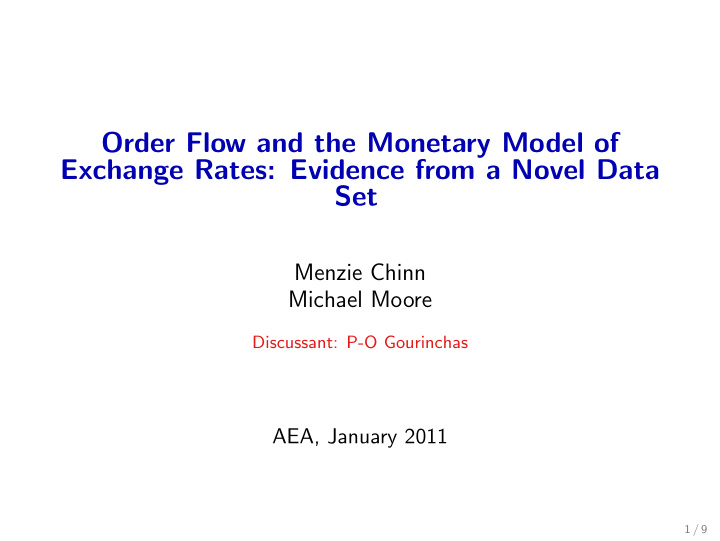



Order Flow and the Monetary Model of Exchange Rates: Evidence from a Novel Data Set Menzie Chinn Michael Moore Discussant: P-O Gourinchas AEA, January 2011 1 / 9
What the paper does • Estimate the Evans & Lyons model, augmented with “monetary fundamental variables” on monthly data for the EUR/USD and JPY/USD bilateral rates. • Finds that the hybrid model performs somewhat better than the standard monetary model 2 / 9
The Evans & Lyons (2002) model • In the Evans & Lyons model, movements in nominal exchange rate can be explained by ‘order flow’, i.e. signed of transactions. • intuition: order flow captures the way disperse information is aggregated in the market. This information builds up and drive movements in the currency. 3 / 9
The Evans & Lyons (2002) model • Original estimates (JPE 2002) were very impressive for the DM/USD and JPY/USD rates. • Subsequent literature has confirmed that order flow has tremendous explanatory power at high frequency (mostly daily) • there is little doubt that order flow is an information rich variable. Key financial institutions guard the information preciously for their own prop-trading desk. 4 / 9
Is the Evans & Lyons (2002) model relevant at macro frequency? • Holy grail issue for this literature: does the order flow leave the trading floor? i.e. does it matter for fluctuations in currency prices over longer horizons. Can it explain the exchange rate disconnect. • Not obvious a priori that it should: • Once information is impounded in price, it should not affect future fluctuations. How long does this realistically take? • Disperse information can slow the information aggregation process, b/c of lack of common knowledge and the dynamics of higher order beliefs. This is something explored explicitly in Bacchetta and van Wincoop AER 2006 who derive an equation similar to equation (1) in the paper. 5 / 9
Do Chinn and Moore estimate the Bacchetta & van Wincoop (2006) model? • No. Instead, they argue rather loosely that the determinants of traditional models can co-exist with order flow and mutually reinforce each other. • the paper starts with a simple model with money in the utility function and preference shocks to the demand for money. • In that model, under the law-of-one price, the nominal exchange rate reflects both the monetary fundamentals (output, money supply) and the preference shock. • the paper then argues that this unobserved and permanent preference shock IS the information that is released through order flow. 6 / 9
How does this work? • households wake up one morning and decide they don’t like holding money any longer. • they go to the market and buy goods • since the supply of goods and money is set, the price level has to jump up so as to induce agents to hold the stock of money. • so in this economy, the price level reveals perfectly the preference shock, and so does the exchange rate. (This should not be surprising since the price level IS the nominal exchange rate) • there is no need for decentralized currency trading here, and it’s not clear exactly why there would be any order flow or how it would impact currency prices. 7 / 9
Empirical Results • the paper’s main contribution is empirical, so we could decide to set aside theoretical considerations, • still, these models are delicate and it would be nice to see the model taken a bit more seriously • On the empirical side, the paper estimates a co-integration relationship between (a) the nominal exchange rate, (b) the monetary fundamentals (money supply, industrial production, interest rates) and (c) the cumulative order flow. • One important contribution of the paper is the length of order flow data: 8 years at monthly frequ. • but 96 observation is probably still too low for unit root and cointegration tests or VECM estimation • evidence on the presence of cointegration variable is not overwhelming, even in the hybrid model. 8 / 9
Empirical Results • The main findings are on the short term dynamics, i.e. introducing cumulative order flow in the co-integration does not improve significantly the fit of the dynamic estimates. • the findings, perhaps not surprisingly, are relatively weak. In particular, there isn’t overwhelming evidence of a cointegration relationship • the paper is careful, explores data issues sensibly and does not overclaim. 9 / 9
Empirical Results • the authors also ambitiously set out to explore out-of-sample performance of their model. They also re-estimate the long-run relationship to ensure no look-ahead bias. • although the Clark-West does not confirm statistically significant improvement in out of sample forecasts, the ratio of RMSE for the EUR/USD is quite promising. • the standards to claim victory in this literature are very low (since nothing quite beats the random walk typically, except perhaps the nxa variable of Gourinchas and Rey (2007) for the US) but the results from this paper indicate to me that there is some potential. • What we would need: longer time series and more formal tests of the model of order flow. 10 / 9
Recommend
More recommend